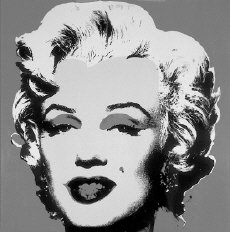Andy Warhol
dal 12/8/2006 al 21/10/2006
Segnalato da
12/8/2006
Andy Warhol
Guild Hall, East Hampton
The exhibition will include 100 pieces including a large late Andy Warhol Self-Portrait (1986), 30 portrait drawings dating from the 1950s, 12 celebrity prints dating from the 1970s and 80s and a group of small paintings made in the mid-60s-portraits of the artists associated with the Leo Castelli Gallery.

John Smith, Guest Curator
Assistant Director for Collections, Exhibition and Research, Andy Warhol Museum
This exhibition will be the first survey of Andy Warhol’s work on Long Island. Guest curated by John Smith the Assistant Director for Collections and Exhibitions at the Andy Warhol Museum, the exhibition will include 100 pieces including a large late Andy Warhol Self-Portrait (1986), 30 portrait drawings dating from the 1950s, 12 celebrity prints dating from the 1970s and 80s and a group of small paintings made in the mid-60s--portraits of the artists associated with the Leo Castelli Gallery.
This exhibition has ben generously sponsored by Altria Group, Inc., with additional funding by Jean and Lucio Noto, IBM and UAG.
Biography of Andy Worhol:
Born in Pittsburgh in 1928 as Andrew Warhola, Andy Warhol came to represent more than just the American condition. He became pivotal in the evolution of artistic production in relationship to mainstream mass-produced culture and commercialism. The founder and most influential figure of the Pop Art movement, Warhol received his training in graphic design from the Carnegie Institute of Technology in 1949. He then moved to New York City to begin his career as a commercial artist where he gained phenomenal success. Andy Warhol began his career as a commercial illustrator, developing ads for the I. Miller Department store in New York. By 1955, Warhol was the most successful and most-influential commercial artist in New York. His first exhibition was in 1962, at the Ferus Gallery in Los Angeles, which included all 32 of his Campbell's Soup Can renditions.
His career took flight when he produced the first of his window displays using enlarged comic strip images. Characters such as Superman and Popeye were among the popular images he incorporated into designer fashion. Needless to say, his department store windows drew a lot of attention, and Warhol garnered a reputation for the extreme. One of Warhol's most important developments was his use of enlarged photographic images which were silk screened directly onto canvas and/or paper. This technique enabled him to produce quickly and cheaply a series of mass-media images that he marketed to the public. Iconographic objects such as Soup Cans, U.S. Dollar Bills, Coca-Cola Bottles, as well as the various faces of celebrities and politicians became highly sought after by art aficionados. This fascination with images in series bled into his all aspects of Warhol's art production. In his studio, he had many assistants who participated in the mass production of prints, posters and paintings that he designed. Most frequently employing the technique of silkscreen printing, Warhol used this method because it made his images identical and easy to proliferate. The Factory was also used as an experimental film studio where Warhol produced over 300 independent films. This studio also became a popular hangout and party destination for celebrities, many of whom became the subject matter of his artwork.
In the late 1960s, Warhol experimented with the medium of film exploring such rhetorical topics as time, boredom, and repetition. He founded inter/VIEW magazine in 1969 (later changed to Interview in 1971), published 'The Philosophy of Andy Warhol: From A to B and Back Again' and continued to produce silk-screens until his death in 1987. Warhol films will be included in the public programming for this exhibition.
The Guild Hall
158 main Street East Hampton, New York NY 11937



